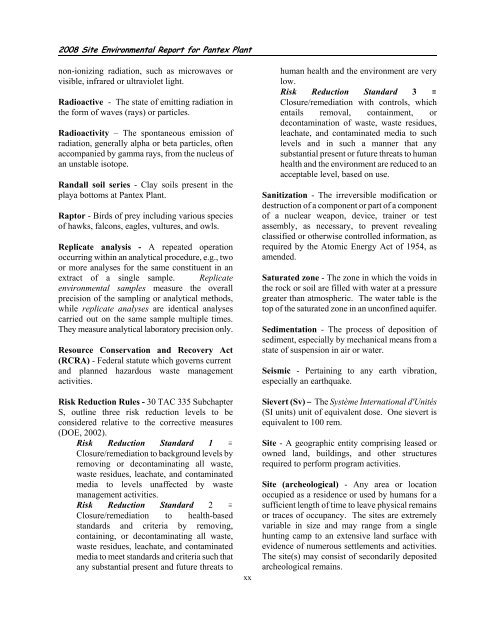2008 Site Environmental Report for Pantex Plant
2008 Site Environmental Report for Pantex Plant
2008 Site Environmental Report for Pantex Plant
You also want an ePaper? Increase the reach of your titles
YUMPU automatically turns print PDFs into web optimized ePapers that Google loves.
<strong>2008</strong> <strong>Site</strong> <strong>Environmental</strong> <strong>Report</strong> <strong>for</strong> <strong>Pantex</strong> <strong>Plant</strong><br />
non-ionizing radiation, such as microwaves or<br />
visible, infrared or ultraviolet light.<br />
Radioactive - The state of emitting radiation in<br />
the <strong>for</strong>m of waves (rays) or particles.<br />
Radioactivity – The spontaneous emission of<br />
radiation, generally alpha or beta particles, often<br />
accompanied by gamma rays, from the nucleus of<br />
an unstable isotope.<br />
Randall soil series - Clay soils present in the<br />
playa bottoms at <strong>Pantex</strong> <strong>Plant</strong>.<br />
Raptor - Birds of prey including various species<br />
of hawks, falcons, eagles, vultures, and owls.<br />
Replicate analysis - A repeated operation<br />
occurring within an analytical procedure, e.g., two<br />
or more analyses <strong>for</strong> the same constituent in an<br />
extract of a single sample. Replicate<br />
environmental samples measure the overall<br />
precision of the sampling or analytical methods,<br />
while replicate analyses are identical analyses<br />
carried out on the same sample multiple times.<br />
They measure analytical laboratory precision only.<br />
Resource Conservation and Recovery Act<br />
(RCRA) - Federal statute which governs current<br />
and planned hazardous waste management<br />
activities.<br />
Risk Reduction Rules - 30 TAC 335 Subchapter<br />
S, outline three risk reduction levels to be<br />
considered relative to the corrective measures<br />
(DOE, 2002).<br />
Risk Reduction Standard 1 /<br />
Closure/remediation to background levels by<br />
removing or decontaminating all waste,<br />
waste residues, leachate, and contaminated<br />
media to levels unaffected by waste<br />
management activities.<br />
Risk Reduction Standard 2 /<br />
Closure/remediation to health-based<br />
standards and criteria by removing,<br />
containing, or decontaminating all waste,<br />
waste residues, leachate, and contaminated<br />
media to meet standards and criteria such that<br />
any substantial present and future threats to<br />
xx<br />
human health and the environment are very<br />
low.<br />
Risk Reduction Standard 3 /<br />
Closure/remediation with controls, which<br />
entails removal, containment, or<br />
decontamination of waste, waste residues,<br />
leachate, and contaminated media to such<br />
levels and in such a manner that any<br />
substantial present or future threats to human<br />
health and the environment are reduced to an<br />
acceptable level, based on use.<br />
Sanitization - The irreversible modification or<br />
destruction of a component or part of a component<br />
of a nuclear weapon, device, trainer or test<br />
assembly, as necessary, to prevent revealing<br />
classified or otherwise controlled in<strong>for</strong>mation, as<br />
required by the Atomic Energy Act of 1954, as<br />
amended.<br />
Saturated zone - The zone in which the voids in<br />
the rock or soil are filled with water at a pressure<br />
greater than atmospheric. The water table is the<br />
top of the saturated zone in an unconfined aquifer.<br />
Sedimentation - The process of deposition of<br />
sediment, especially by mechanical means from a<br />
state of suspension in air or water.<br />
Seismic - Pertaining to any earth vibration,<br />
especially an earthquake.<br />
Sievert (Sv) S The Système International d'Unités<br />
(SI units) unit of equivalent dose. One sievert is<br />
equivalent to 100 rem.<br />
<strong>Site</strong> - A geographic entity comprising leased or<br />
owned land, buildings, and other structures<br />
required to per<strong>for</strong>m program activities.<br />
<strong>Site</strong> (archeological) - Any area or location<br />
occupied as a residence or used by humans <strong>for</strong> a<br />
sufficient length of time to leave physical remains<br />
or traces of occupancy. The sites are extremely<br />
variable in size and may range from a single<br />
hunting camp to an extensive land surface with<br />
evidence of numerous settlements and activities.<br />
The site(s) may consist of secondarily deposited<br />
archeological remains.




